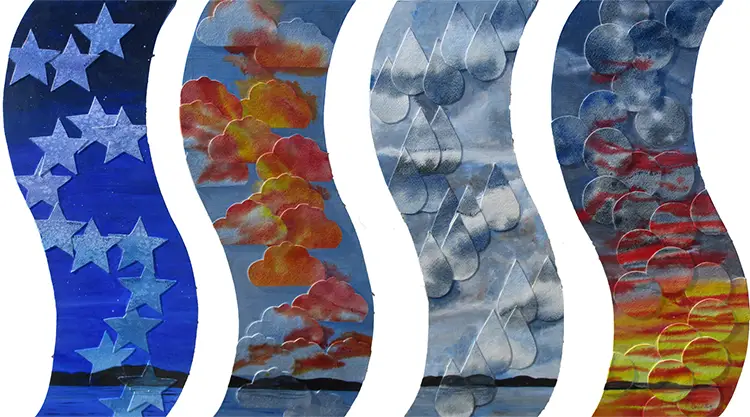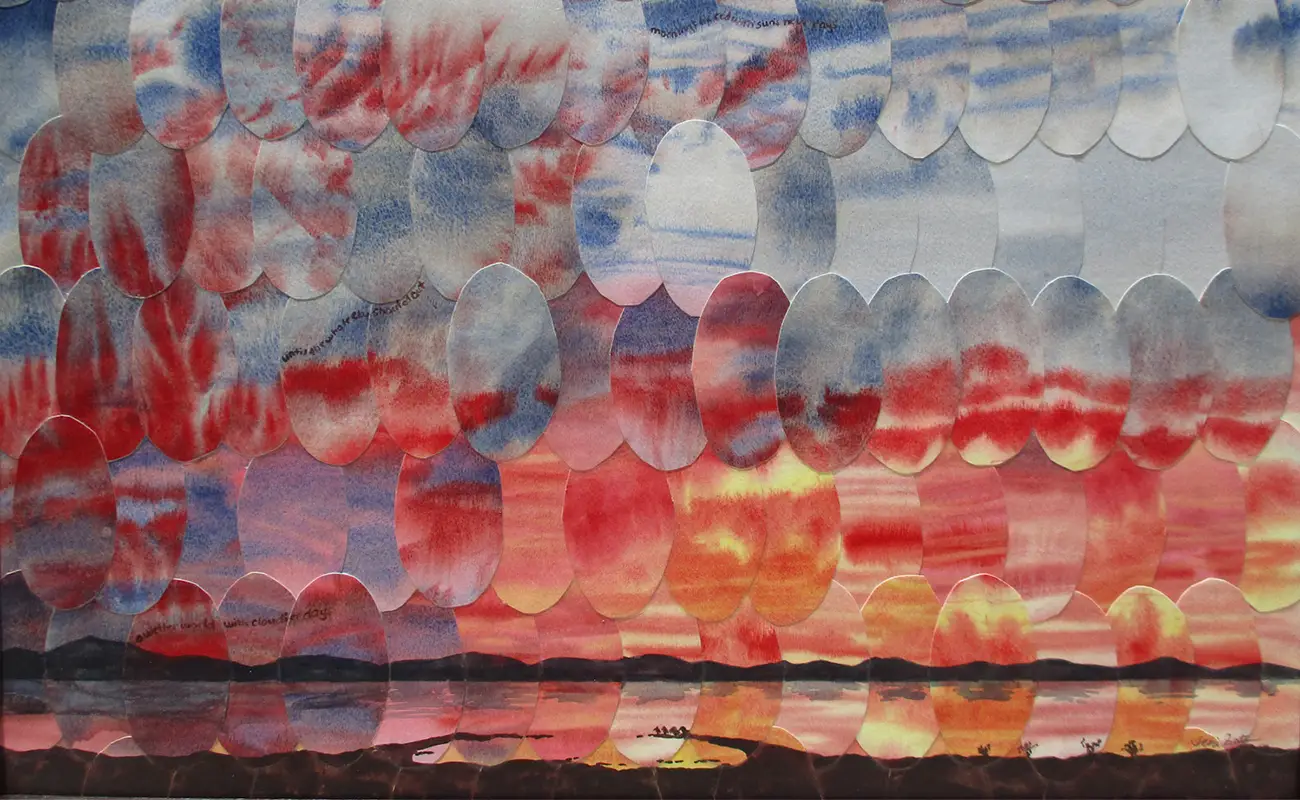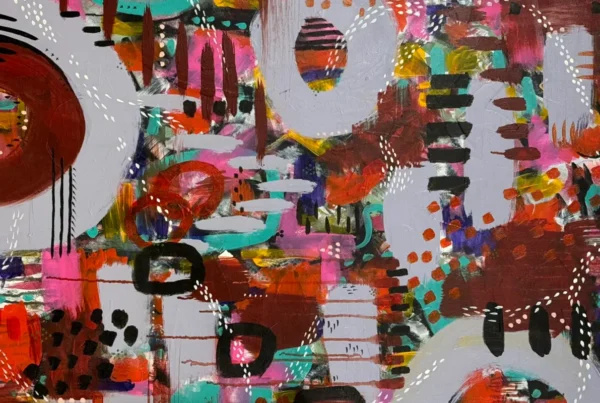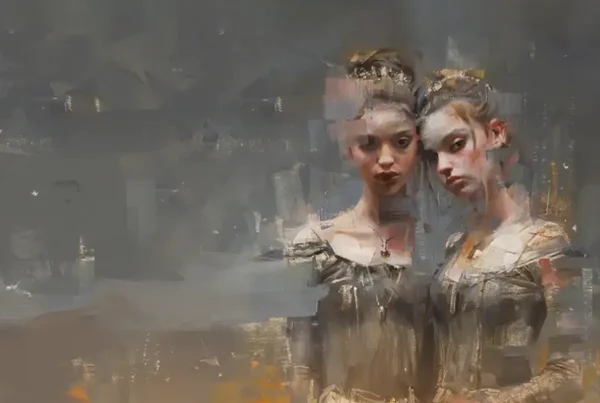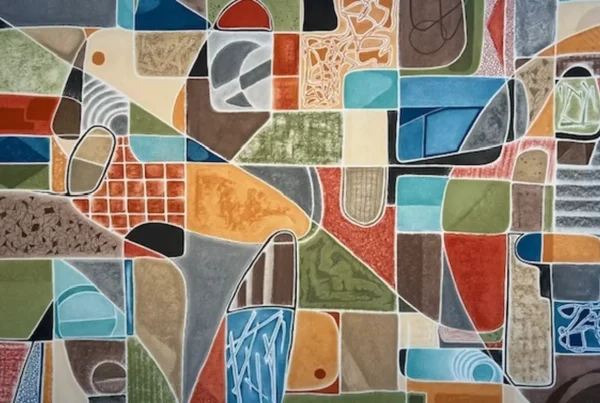“My capture of the skies and abstractions thereof aim to help us realize how small we are in the face of the sky, and yet how it unites us all.”
Echoes from the Edge of the Sky
From the desert basin of Salton City, California, Jeni Bate crafts a visual language rooted in both the tangible and the ephemeral. Her artistic journey is anything but linear, marked by a unique synthesis of scientific discipline and creative reinvention. Originally from Wales, Bate’s childhood passion for painting was temporarily sidelined by academic pursuits. She initially pursued microbiology at Leeds University, but a serendipitous encounter with a computer science student’s coursework catalyzed a profound redirection. What followed was a 31-year career in computer technology, which ultimately brought her to the United States. While seemingly unrelated, this background laid the groundwork for a precision and structure that would later inform her dynamic artistic processes.
The pivotal transformation occurred in 2001 when Bate, then experimenting with photography, experienced an intuitive breakthrough: a sudden, undeniable pull toward painting. Photography, though initially fulfilling, began to feel restrictive—a medium bounded by what the lens could capture. This epiphany led her to embrace the brush, driven by a need to transcend literal representation and explore the interpretive layers of visual perception. The transition was not merely a shift in medium but an awakening to a deeper creative necessity. Painting offered the latitude she craved, a way to externalize the vast, emotional experiences that the natural world—and particularly the sky—evoked in her.
At the core of Bate’s work lies an enduring preoccupation with the sky. To her, it is not merely background but the central, ever-shifting character in the narrative of life. Her fascination encompasses everything from the poetry of dawn and dusk to the complex beauty of cloud formations. She challenges the often-negative associations we attach to cloudy weather, reminding us that rain sustains life and that the sky governs much of the physical world below. Through her vivid portrayals, Bate invites us to confront our own smallness while recognizing the unity that the sky imposes on all human experience. Her aim is to reframe the ordinary as extraordinary, using the heavens as a mirror of collective emotion and existential scale.
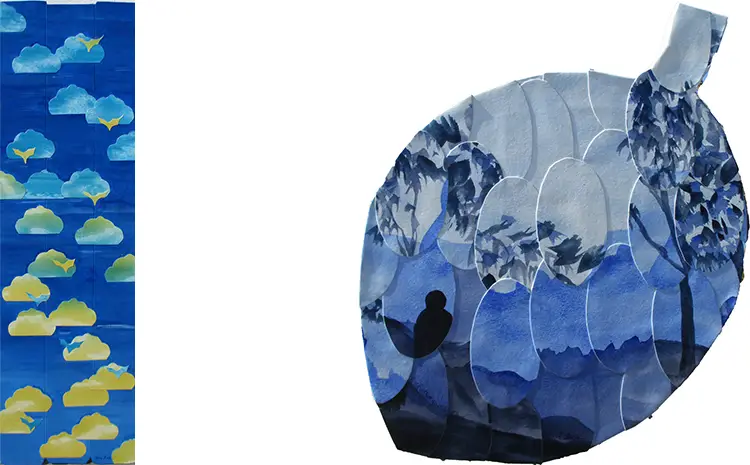
Jeni Bate: Refracturing Perception
Bate’s self-described technique, “refracturing,” forms the signature structure of her visual storytelling. Though the term is borrowed from quilting, Bate’s “refracturing” technique is entirely her own: painting a scene one or multiple times, cutting it into fragments, and reassembling the pieces into a new composition. This approach enables her to experiment with disrupted continuity and juxtaposition, often pairing edges that only partially align. The results are visually arresting—pieces that oscillate between cohesion and chaos, drawing the viewer into a layered experience of visual processing. In 2016, the international collage publication Kolaj acknowledged refracturing as an official method, validating Bate’s innovative approach within the contemporary art discourse.
The refractured technique aligns seamlessly with Bate’s understanding of how humans visually engage with the world. Rather than perceiving a scene as a monolithic whole, our eyes dart from detail to detail, assembling understanding in fragments. Her art mirrors this cognitive process, offering viewers not just a scene to behold but a dynamic process of discovery. This fragmentation invites contemplation, urging viewers to reconstruct meaning on their own terms. The partial matches and intentional disjunctions create a rhythm that is both cerebral and emotional, tapping into a deeper way of seeing that transcends straightforward realism.
Adding another dimension to her work, Bate incorporates original poetry directly into her paintings. This fusion of visual and textual art allows her to articulate the emotional undercurrents of each piece, guiding the observer toward a specific resonance without dictating interpretation. Her poetry becomes the soul of the work, giving voice to its emotional landscape while remaining open to the viewer’s personal connection. This integration of word and image not only expands the expressive capacity of each piece but also reflects her broader creative identity—one in which painting and poetry are not separate pursuits but interwoven strands of the same impulse.
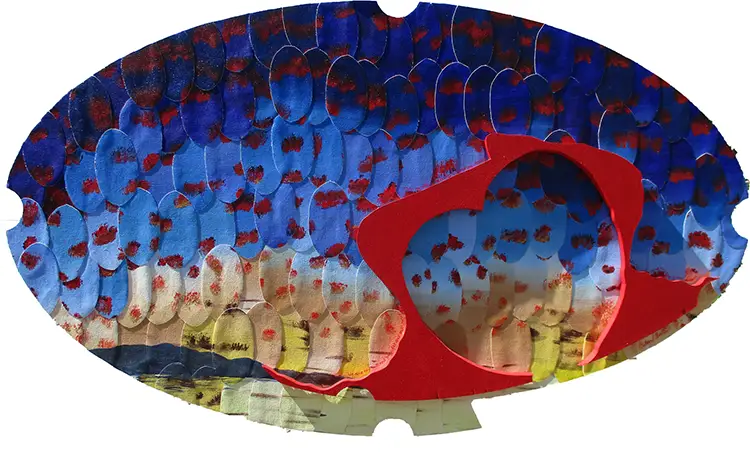
Fragments of Memory and Loss
Among Bate’s numerous creations, one piece in particular—Further/Closer—stands as a deeply personal exploration of grief, connection, and time. Originally developed as a teaching tool to demonstrate depth through value contrast, the work evolved far beyond its instructional origins. It features a silhouetted figure beside a tree, layered against a backdrop of receding mountain ranges. Painted on a hand-cut, repurposed panel, the composition carries both visual and symbolic weight. Once completed, Bate wrote a haiku into the surface: “The further your death / the closer I am to mine / time can’t divide us.” The moment she finished writing, the piece took on an unexpected emotional gravity.
The haiku immediately called to mind a close friend who had recently passed away, transforming the painting into a space of mourning and remembrance. Through this spontaneous association, Further/Closer became a vessel for processing loss—its refractured structure echoing the fragmented, non-linear nature of grief. The layers of mountains became more than compositional devices; they signified the distance and proximity of memory, the way love and loss are intertwined across the geography of time. It is in works like this that Bate’s artistic philosophy crystallizes: art as a living, breathing response to personal history, imbued with the capacity to hold and transmute emotional truths.
The piece also exemplifies Bate’s commitment to sustainability and resourcefulness. Created on upcycled material, Further/Closer reflects her broader practice of repurposing and adapting unexpected elements into her work. This inclination toward transformation—of materials, of methods, of meaning—resonates throughout her portfolio. Rather than presenting a polished or sanitized view of the world, she embraces its inconsistencies, using refracturing as both method and metaphor. In doing so, she gives viewers permission to see beauty in imperfection, to find cohesion within the broken.
Incorporating the tactile quality of wood, the hand-cut shape of the panel enhances the physicality of Further/Closer, reinforcing the idea that art need not be constrained by conventional forms. For Bate, each decision—material, method, motif—serves a deeper thematic intention. Whether capturing the emotional topography of the sky or tracing the contours of memory, she builds work that is not merely observed but experienced, both intellectually and emotionally. This approach marks her as a creator who refuses to separate aesthetic innovation from human resonance.
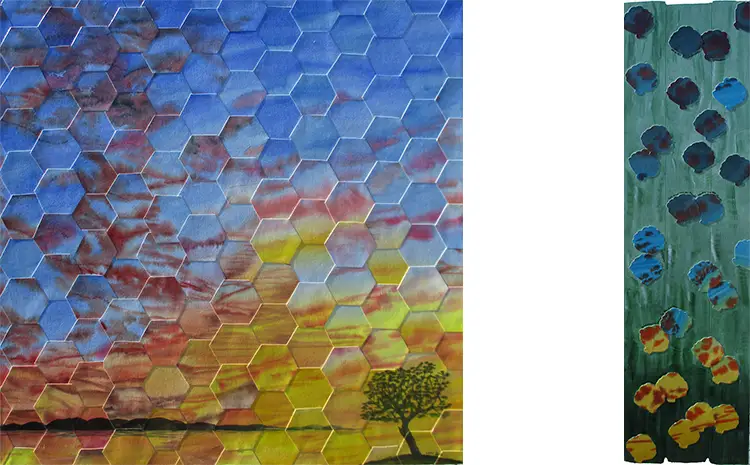
Jeni Bate: A Studio in Motion
Inside her creative space, Bate maintains an adaptable, multi-functional environment designed to support the many-layered demands of her mixed media technique. Her studio, outfitted with several worktables and stocked with paints, brushes, and canvases, reflects a balance between focus and fluidity. Though she typically prefers to engage with one piece at a time, the nature of her process—particularly the extensive drying periods required for refracturing—means she often has multiple works in various stages of completion. This rhythm of activity and pause fosters an atmosphere where experimentation thrives, and where moments of rest are as integral to the work as moments of creation.
Her preferred medium arose not through meticulous planning but through a series of trial-and-error discoveries—what she humorously refers to as “three mistakes and a theft.” The first mistake involved painting on palm bark, only to realize it couldn’t be mounted securely. The second was attempting to salvage the situation with shadow boxes, which proved visually unappealing. The third, a miscut watercolor background, unexpectedly revealed the aesthetic potential of fragmented reassembly. That accident sparked the conceptual birth of refracturing, allowing Bate to embrace serendipity as a guiding force. From these missteps emerged a methodology uniquely her own, one that celebrates the unexpected and reframes failure as opportunity.
Looking ahead, Bate envisions projects that push the boundaries of shape and structure. Her interest in working with wood has inspired ideas for multi-part and irregularly contoured pieces, further emphasizing her inclination toward the unconventional. This desire to break from traditional rectangular formats aligns with her thematic focus on fluidity and impermanence. By challenging not only what is seen but how it is seen—whether through shaped panels, poetic integration, or fractured surfaces—she continues to redefine the parameters of her practice. Alongside her visual art, Bate has also authored eight self-published books, six of which blend poetry and painting—one being a humorous, illustrated story in verse—extending her exploration of hybrid expression into the literary space. Each endeavor reinforces her vision of creativity as multifaceted and uncontained, much like the sky that remains her eternal muse.
